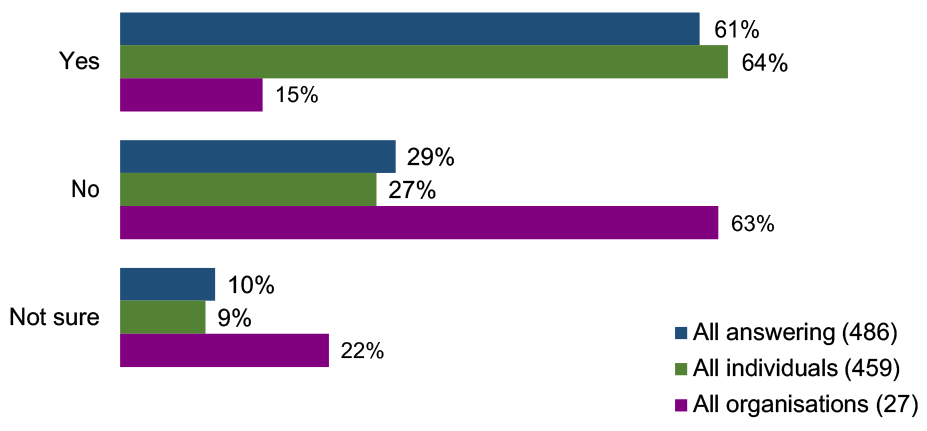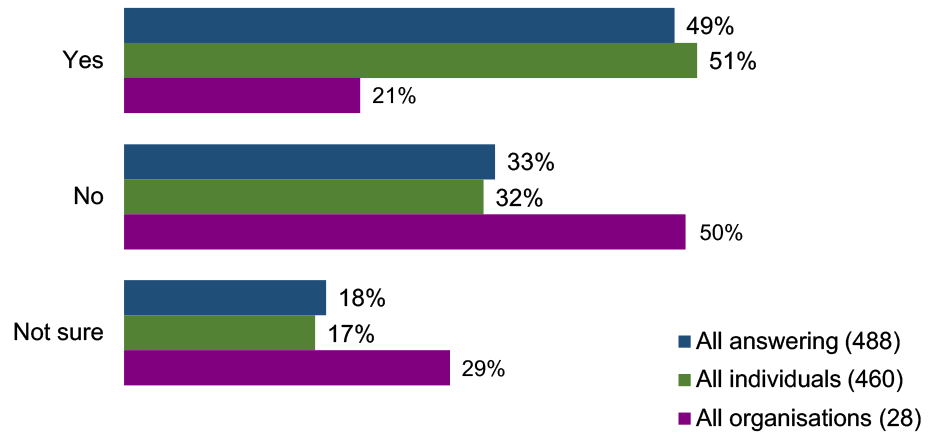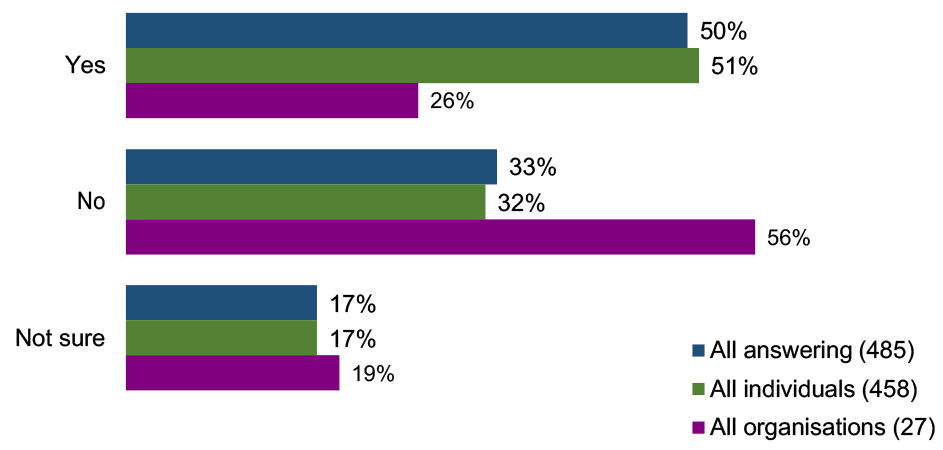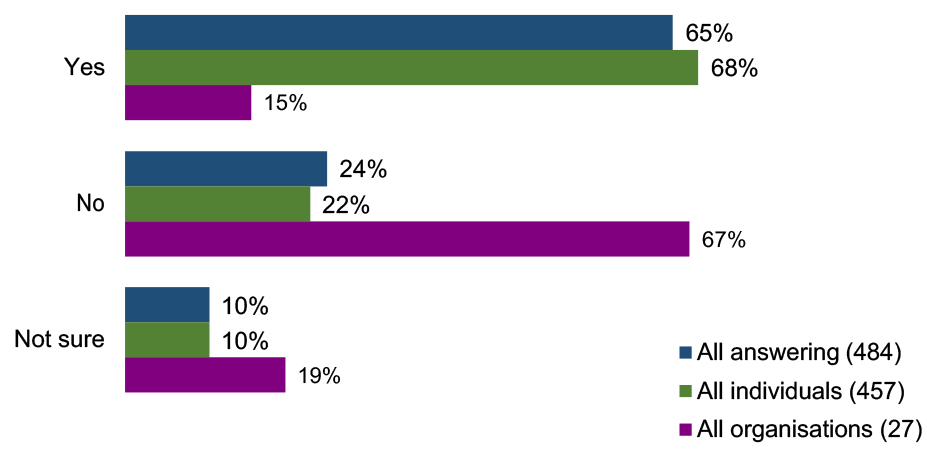Schools - prescribing the minimum annual number of learning hours: consultation analysis
A report setting out a quantitative and qualitative analysis of response to a consultation prescribing the minimum annual number of learning hours that was held in 2023.
3. Quantitative analysis
This chapter presents the results of the four closed questions in the consultation.
We have provided a data table for each question. For transparency, each table begins with the number of respondents from the total sample of 496 respondents who selected each response and the corresponding percentage.
However, as not all respondents answered each closed question, each table then presents the number and percentage of responses among those answering each question, broken down by individual and organisation responses and by type of organisation.
We have also included a bar chart showing the percentage of responses among those answering each question.
Please note that figures in the tables may not add up to 100% due to rounding.
3.1 Respondent surveys
In addition to the quantitative data collected via Citizen Space, four organisations cited results from their own surveys. More information is provided in Appendix A.
Regarding overall views on the proposals, a survey of members of the CLD (Community Learning and Development) Standards Council members found 77.5% in agreement, as were 69% of parents who responded to a survey by the National Parent Forum of Scotland and 68% of parents who responded to a survey by Connect. Conversely, a majority of the Pedagogy, Praxis and Faith Research and Teaching Group, School of Education, University of Glasgow did not support the proposal.
Question 1: Should the Scottish Government set in law the minimum learning hours pupils in Scotland should receive?
| n= | % Yes | % No | % Not sure | % No answer | |
|---|---|---|---|---|---|
| All respondents (n=) | 496 | 298 | 140 | 48 | 10 |
| All respondents (%) | 496 | 60 | 28 | 10 | 2 |
| All answering (%) | 486 | 61 | 29 | 10 | - |
| All individuals | 459 | 64 | 27 | 9 | - |
| - Parent | 299 | 69 | 22 | 8 | - |
| - Teacher | 106 | 52 | 37 | 11 | - |
| - Education practitioner | 19 | 63 | 26 | 11 | - |
| - School support staff | 7 | 57 | 43 | 0 | - |
| - Other individuals | 28 | 57 | 32 | 11 | - |
| All organisations | 27 | 15 | 63 | 22 | - |
| - Local authorities and their representative bodies | 14 | 7 | 86 | 7 | - |
|
5 | 40 | 0 | 60 | - |
| - Representative/advocacy bodies for parents | 2 | 0 | 100 | 0 | - |
| - Representative/advocacy bodies for teachers | 3 | 0 | 67 | 33 | - |
| - Trade Unions | 1 | 0 | 100 | 0 | - |
| - Regulator | 1 | 0 | 0 | 100 | - |
| - Other organisations | 1 | 100 | 0 | 0 | - |

Three fifths (61%) of those who answered Q1 answered yes, the Scottish Government should set in law the minimum learning hours pupils in Scotland should receive; three in ten (29%) disagreed, and one in ten (10%) were unsure.
Almost two thirds (64%) of individuals agreed that a minimum number of learning hours should be set out in law. A majority of each type of individual respondent supported the proposals, ranging from 69% of parents to 52% of teachers.
Organisations, however, were more likely to be opposed to the proposal. Among all organisations who answered, 63% answered no, 15% yes, and 22% were unsure. While there were some differences by type of organisation that answered, most (86%) local authorities were opposed; Argyll and Bute Council answered yes, and Perth and Kinross Council were unsure.
Question 2: Do you agree that the minimum annual learning hours should be 950 hours for primary schools?
| n= | % Yes | % No | % Not sure | % No answer | |
|---|---|---|---|---|---|
| All respondents (n=) | 496 | 241 | 159 | 88 | 8 |
| All respondents (%) | 496 | 49 | 32 | 18 | 2 |
| All answering (%) | 488 | 49 | 33 | 18 | - |
| All individuals | 460 | 51 | 32 | 17 | - |
| - Parent | 299 | 53 | 29 | 18 | - |
| - Teacher | 107 | 52 | 34 | 14 | - |
| - Education practitioner | 19 | 37 | 42 | 21 | - |
| - School support staff | 7 | 43 | 14 | 43 | - |
| - Other individuals | 28 | 39 | 46 | 14 | - |
| All organisations | 28 | 21 | 50 | 29 | - |
| - Local authorities and their representative bodies | 14 | 14 | 86 | 0 | - |
| - Representative/advocacy bodies for children, including those with additional support needs | 5 | 40 | 0 | 60 | - |
| - Representative/advocacy bodies for parents | 2 | 0 | 50 | 50 | - |
| - Representative/advocacy bodies for teachers | 3 | 0 | 0 | 100 | - |
| - Trade Unions | 2 | 50 | 50 | 0 | - |
| - Regulator | 1 | 0 | 0 | 100 | - |
| - Other organisations | 1 | 100 | 0 | 0 | - |

Half (49%) of those answering Q2 agreed that there should be a minimum of 950 learning hours per year in primary schools. One third (33%) disagreed and 18% were unsure.
Half (51%) of individuals agreed, although support was higher among parents (53%) and teachers (52%) than among other groups. Education practitioners were more likely to disagree than agree (42% compared to 37%), and school support staff were more likely than other groups to be unsure (43%).
One in five (21%) organisations were in favour of the proposal, with half (50%) opposed and 29% unsure. Opposition was highest among local authorities (86%), with only Argyll and Bute Council and East Dunbartonshire Council in favour. Opinions among the small number of other organisations varied considerably.
Question 3: Do you agree that the minimum annual learning hours should be 1045 hours for secondary schools?
| n= | % Yes | % No | % Not sure | % No answer | |
|---|---|---|---|---|---|
| All respondents (n=) | 496 | 241 | 162 | 82 | 11 |
| All respondents (%) | 496 | 49 | 33 | 17 | 2 |
| All answering (%) | 485 | 50 | 33 | 17 | - |
| All individuals | 458 | 51 | 32 | 17 | - |
| - Parent | 297 | 53 | 30 | 18 | - |
| - Teacher | 107 | 50 | 36 | 14 | - |
| - Education practitioner | 19 | 53 | 32 | 16 | - |
| - School support staff | 7 | 57 | 14 | 29 | - |
| - Other individuals | 28 | 36 | 46 | 18 | - |
| All organisations | 27 | 26 | 56 | 19 | - |
| - Local authorities and their representative bodies | 14 | 14 | 86 | 0 | - |
|
5 | 40 | 0 | 60 | - |
| - Representative/advocacy bodies for parents | 2 | 50 | 50 | 0 | - |
| - Representative/advocacy bodies for teachers | 3 | 0 | 67 | 33 | - |
| - Trade Unions | 1 | 100 | 0 | 0 | - |
| - Regulator | 1 | 0 | 0 | 100 | - |
| - Other organisations | 1 | 100 | 0 | 0 | - |

The closed question results for Q3 were very similar to Q2. Half (50%) of those answering agreed that the minimum annual learning hours should be 1045 hours for secondary schools. One third (33%) disagreed and 17% were unsure.
Among individuals, 51% agreed, with relatively similar levels of support recorded by most type of individual, ranging from 57% among school support staff to 50% of teachers.
One quarter (26%) of organisations supported the suggested number of hours, though most were opposed (56%) or unsure (19%). Most (86%) local authorities were opposed, again with the exception of Argyll and Bute Council and East Dunbartonshire Council.
Question 4: Do you agree with the suggested definition of learning hours set out at paragraph 2.1 in the consultation paper?
Paragraph 2.1 defines learning hours as: “Learning hours are the period of teaching that learners receive within the school day. In most cases, they do not include lunch and other break times or extra-curricular activities or provision such as breakfast clubs that may take place around the core school day. It has been accepted practice for at least the last 40 years that around 25 hours per week (or 950 hours per academic year) of teaching time is made available in most local authority run primary schools; and 27.5 hours per week (or 1045 hours per academic year) in most local authority run secondary schools.”
| n= | % Yes | % No | % Not sure | % No answer | |
|---|---|---|---|---|---|
| All respondents (n=) | 496 | 316 | 118 | 50 | 12 |
| All respondents (%) | 496 | 64 | 24 | 10 | 2 |
| All answering (%) | 484 | 65 | 24 | 10 | - |
| All individuals | 457 | 68 | 22 | 10 | - |
| - Parent | 297 | 70 | 18 | 11 | - |
| - Teacher | 107 | 64 | 31 | 6 | - |
| - Education practitioner | 18 | 72 | 22 | 6 | - |
| - School support staff | 7 | 71 | 14 | 14 | - |
| - Other individuals | 28 | 61 | 29 | 11 | - |
| All organisations | 27 | 15 | 67 | 19 | - |
| - Local authorities and their representative bodies | 13 | 8 | 85 | 8 | - |
|
5 | 20 | 40 | 40 | - |
| - Representative/advocacy bodies for parents | 2 | 0 | 100 | 0 | - |
| - Representative/advocacy bodies for teachers | 3 | 33 | 33 | 33 | - |
| - Trade Unions | 2 | 50 | 50 | 0 | - |
| - Regulator | 1 | 0 | 0 | 100 | - |
| - Other organisations | 1 | 0 | 100 | 0 | - |

Two thirds (65%) of those answering Q4 agreed with the suggested definition of learning hours set out in the consultation paper. One quarter (24%) disagreed, and one in ten (10%) were unsure. Broadly similar levels of all types of individuals agreed.
Overall 68% agreed with the definition, ranging from 72% of education practitioners to 64% of teachers and 61% among other individuals.
Among organisations, two thirds (67%) disagreed with the definition, 19% were unsure and 15% agreed. Most (85%) local authorities did not support the definition; East Dunbartonshire Council were in favour and Perth and Kinross Council were unsure. The other three organisations who agreed with the definition were RNIB Scotland, AHDS and Pedagogy, Praxis and Faith Research and Teaching Group, School of Education, University of Glasgow.
Contact
Email: leanne.gardiner@gov.scot
There is a problem
Thanks for your feedback